|
Potsdam is an important part of European
cultural history – a splendid centre of European Enlightenment, which
reached its climax in the 18th century in the architectural and artistic
design of Frederick the Great’s palace. The palace complex of
Sanssouci, with its beautiful, extensive park, is both magnificent and
playful and has been designated a World Heritage Centre of Culture by
UNESCO. Every year, it enchants millions of visitors from around the
world. The town of Potsdam, numbering some 300,000 inhabitants, is the
capital of the federal province of Brandenburg. This former garrison
town has much to delight its visitors, including small palaces and old
churches, idyllic parks and historic immigrant settlements.
|
In July and August 1945, the heads of government
of the United States (Harry Truman), the USSR (Joseph Stalin) and Great
Britain (Winston Churchill) met in Schloss Cecilienhof, in order to seal
the future of Germany in a treaty. Vitally important points such as the
demilitarization of Germany, the level of reparations to be paid, the
punishment of war criminals, the resettlement of Germans from Poland and
the new borders of Germany were decided here.
|
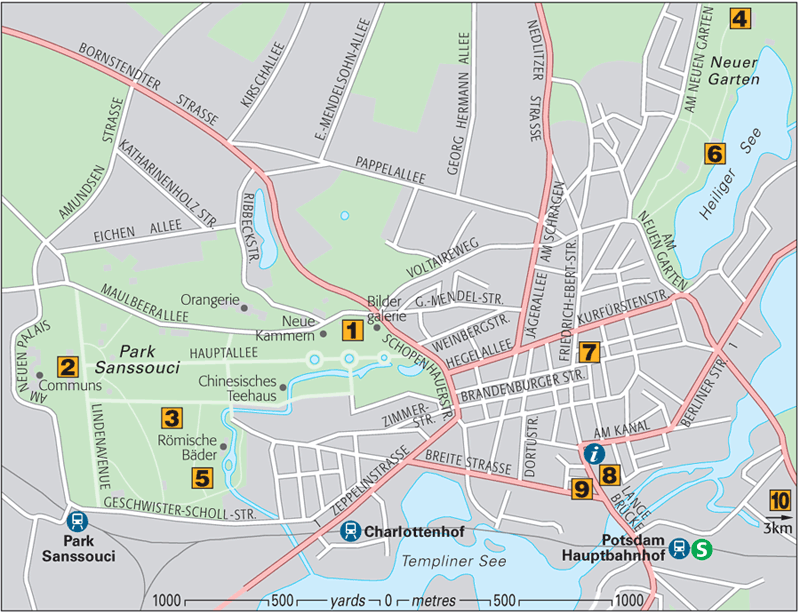
|
S-Bahn S7 goes to Potsdam from Berlin. The journey takes about 45 minutes from S station Friedrichstr.
|
|
Top 10 SightsSchloss Sanssouci The
Prussian King Frederick the Great wished to live “sanssouci”, in a
palace outside the boundaries of the hated city – the French phrase
means “without worries”. In 1745, Frederick commissioned his favourite
architect Georg Wenzeslaus von Knobelsdorff to plan and construct this
magnificent Rococo palace according to his own designs. The
main building with its yellow façade rises proudly above the former
terraced vineyards, leading up to the domed building and its elegant
marble hall at the centre of the palace complex. In both its design and
shape, the marble hall pays homage to the Pantheon in Rome. To its left
and right are some very attractive rooms designed by von Knobelsdorff
and Johann August Nahl; these include the famous concert room, adorned
with paintings by Antoine Pesne, and Frederick’s library. In this wing,
the monarch liked to play the flute or to philosophize with Voltaire.
Valuable paintings by Frederick the Great’s favourite painter, the
French artist Antoine Watteau, adorn the palace walls.
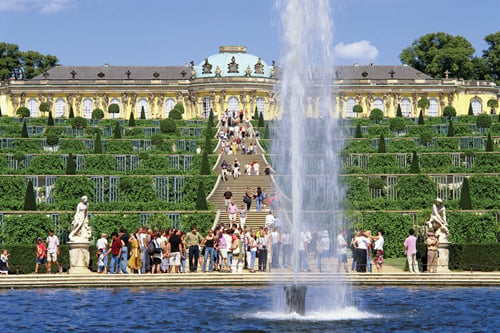
Neues Palais To
the north of Sanssouci palace park rises the Baroque Neues Palais. One
of Germany’s most beautiful palaces, it was built in 1763–9 for
Frederick the Great according to designs by Johann Gottfried Büring,
Jean Laurent Le Geay and Carl von Gontard. The vast two-storey structure
comprises 200 rooms, including the Marmorsaal (marble hall), a lavishly
furnished ballroom, and the Schlosstheater, where plays are once more
performed today. Frederick’s private chambers are equally splendid,
especially his study furnished in Rococo style, the upper gallery with
valuable parquet flooring and the Oberes Vestibül, a room clad entirely
in marble.
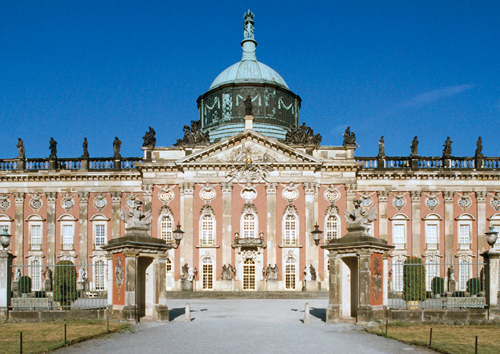
Neues Palais
Schlosspark Sanssouci It
is easy to while away an entire day in the extensive palace park, which
covers 287 hectares (709 acres) of land. Of the many charming buildings
hidden in the lavishly designed landscape garden, the Rococo-style
Chinesische Haus, built in 1754–6 by Johann Gottfried Büring, is
especially worth seeking out. Originally it served as a tea-house and dining room, and it now houses an exhibition of porcelain pieces from East Asia.
The Römische Bäder (Roman Baths), a group of pavilions next to the
lake, are also inspired by historic models. Modelled on an Italian
Renaissance villa, they were built between 1829 and 1840 by Friedrich
Karl Schinkel as guest and bathing houses. The
Orangerie, constructed in 1851–60 by Friedrich August Stüler, was also
originally intended to accommodate the king’s guests. Today it houses a
small gallery of paintings. Chinesische HausRömische BäderOrangerie
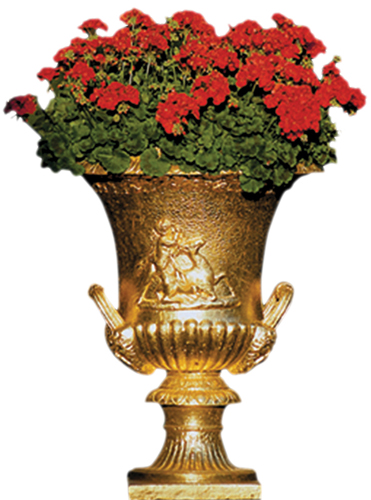
Vase in Park Sanssouci
Schloss Cecilienhof This
little palace, built in the style of an English country manor house,
entered the history books in 1945, when Germany’s fate was sealed by the
Potsdam Conference. Built in 1914–17, the palace is a UNESCO World
Heritage Site and is now used as a hotel. It also houses a small
exhibition documenting the Conference and the palace’s furnishings.
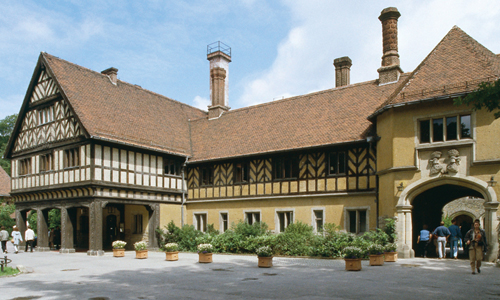
Schloss Charlottenhof A
small Neo-Classical palace in Park Sanssouci, built in 1829 by Schinkel
for the heir to the throne, Friedrich Wilhelm IV. Particularly worth
seeing is the tent-like Humboldtsaal. Marmorpalais This
small, early Neo-Classical palace at the side of the lake was built in
1791–7 by Carl Gotthard Langhans and others. It features an elegant
concert hall as well as contemporary furniture and porcelain.

Marmorpalais
Holländisches Viertel A
pleasant way to explore the district of Potsdam is a walk through the
historic Old Town, with its art galleries, cafés and restaurants. Built
between 1733 and 1742, the area originally served as a settlement for
Dutch workers after whom it is now named. The small red-brick buildings
are decorated with attractive stucco ornaments. Nikolaikirche Potsdam’s
most attractive church was designed by Schinkel in 1830 in an early
Neo-Classical style. Its giant dome is particularly striking.
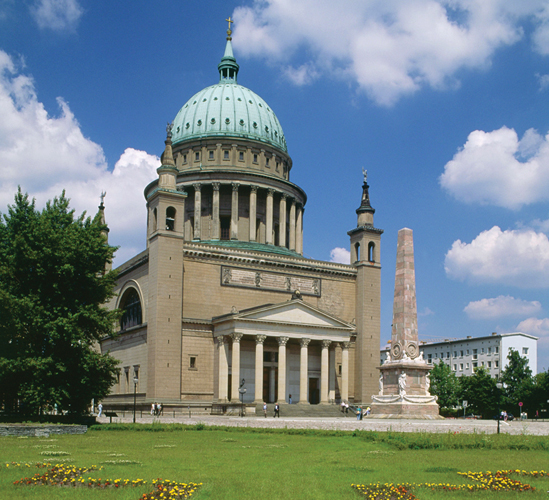
Nikolaikirche on Alter Markt
Marstall (Filmmuseum) The
small museum, based in the Baroque former stable buildings of the
king’s town residence, uses old cameras, props and projectors to
document the history of German film. Breite Str. 1a 10am–6pm Mon–Sun 0331 27 18 10
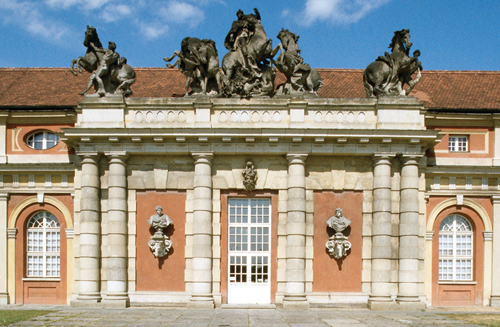
Marstall (Filmmuseum)
Filmpark Babelsberg The
Filmpark offers visitors a tour of the legendary UFA-Studios, which
were among the world’s most important when they operated here in
Babelsberg from 1917 to 1945. Exciting U-boat trips, stunt performances
and special effects are shown. Großbeerenstr Apr–Oct: 10am– 6pm daily 0331 721 27 50
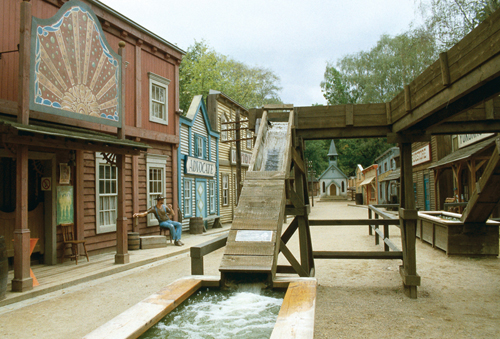
|